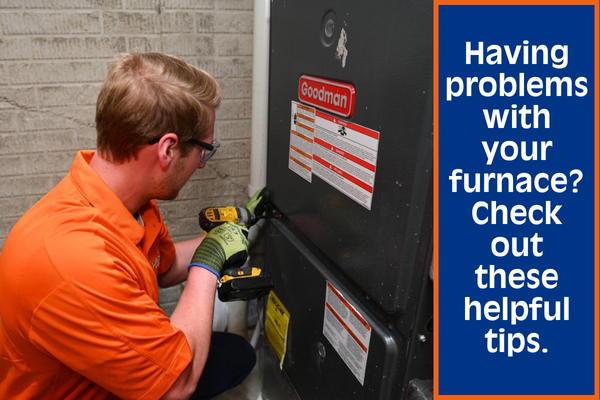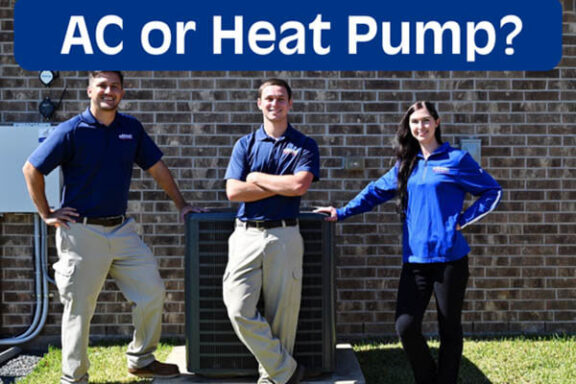Furnace Problems and Troubleshooting Tips
Heating Systems Seasonal HVAC Tips

Tackle Common Furnace Problems With Troubleshooting Tips
Cold weather requires a furnace that works when you need it most. An unreliable or malfunctioning furnace can leave you in the cold — literally. When you have furnace problems, especially when the temperature drops, your first instinct may be to panic. But before you take drastic measures, there are some simple troubleshooting steps you can take that may get your HVAC system working again. Here, we’ll take a look at some of the most common furnace problems, and then look at a few ways you can potentially resolve the issues before you have to call in an HVAC professional.
Understanding How Your Furnace Works
First, whether you installed your current heating system or it was installed by a previous homeowner, it pays to learn as much as you can about it. This way, you’ll know best how to troubleshoot any problems you’re having now, or might have in the future.
Basic Components of a Furnace
Let’s start by understanding all the parts that make up most furnaces. Whatever type of furnace you have in your home, you can usually expect it to contain the following:
- Thermostat: The thermostat is what monitors the temperature in your home and signals your furnace to kick on and off in order to maintain that temperature.
- Burner: The burner sits inside the heat exchanger and is what creates the heat in your furnace by releasing fuel into the combustion chamber.
- Ignitor: The ignition system is what creates the spark that burns fuel in your furnace. In some furnaces, the pilot light is the ignitor, while more modern systems often have electric igniters.
- Heat exchanger: The heat exchanger is a piece of metal that heats up and warms the air that blows through your furnace, pushing it into your home.
- Flame sensor: The flame sensor detects whether a flame has been ignited inside your furnace. If not, it will cut off the gas supply to prevent leakage of harmful fumes.
- Blower motor and fan: This system is what moves air through your ducts and out your vents to keep your home warm.
- Inducer fan: The inducer fan pulls air through the furnace to expel any exhaust or unburned gases.
- Air filter: An air filter traps dust and small debris before it can enter the ducts and pass into your home. It also helps keep the furnace clean and lessens wear and tear.
- Gas valve: The gas valve is a mechanism that opens and closes to allow fuel to flow to the pilot light and burner.
- Control board: A control board operates like a computer circuit board. It’s essentially the brain that operates your furnace. It’s what sets the entire heating cycle into motion.
Common Types of Furnaces
You probably already know what type of furnace you have, but did you know that the type of furnace can influence the sorts of issues you might have? Here are the top types of furnaces:
- Gas: There are two subtypes of gas furnaces: natural gas and propane. Natural gas is most common, but propane can be used in areas where natural gas isn’t available and there’s space for a large tank.
- Electric: These furnaces use electricity to heat internal metal coils, which generate the warmth that’s distributed throughout your home.
- Oil: Oil furnaces are not as common as other types. They burn oil to generate heat, and are often seen as less efficient and more expensive to operate.
- Heat pump: Heat pumps are a relatively new option for home heating, in which heat is drawn from the outside air and then pumped through the house. Heat pumps are technically not furnaces, though they provide the same function.
Common Problems with Furnaces and How to Troubleshoot Them
Now that we know the basics, we can start to explore the most likely culprits behind your furnace issues and what you can do about them.
Furnace Won’t Turn On
If your furnace won’t turn on at all, there are a few quick steps you can take before you call for professional help.
- Check the power: Check all power switches and electrical connections to make sure they are turned on and working properly. Ensure the circuit breaker for the furnace hasn’t been tripped. Reset the breaker and flip the furnace switch to see if that turns the furnace back on. Repeated tripping of the breaker could be a sign of a serious electrical problem that needs professional attention.
- Check the thermostat: Make sure the thermostat is set to a temperature that is appropriate for the season and higher than the current room temperature. Move the settings up or down a few degrees to see if that causes the furnace to kick on. If your thermostat is a programmable model, make sure it is set to the “heating” function and that it’s receiving power. Change the batteries, if necessary.
Furnace Blows Cold Air
If your furnace kicks on as expected, but the air coming out is cold, check these potential issues first:
- Check the pilot light: Older systems may have a pilot light that provides ignition for the fuel the furnace uses. Make sure the pilot light is lit and if it isn’t, re-light it (or call a professional to help you do this). If your furnace has electronic ignition, make sure the unit is working properly. We highly recommend you contact professionals to make any adjustments to the pilot light.
- Check the fan setting: The problem could be as simple as the wrong setting for your fan. On your thermostat, make sure the fan is set to “auto,” and not “on.” This means the air will blow only when the furnace is actively heating your home. If it’s set to “on,” it will continue to blow air through your house even when it’s not heating.
- Check fuel supplies: Ensure your fuel-burning furnace is receiving fuel, either from the local utility connection if it’s a gas furnace or from the fuel storage tank if it’s an oil furnace. Make sure the utility gas supply is on or there is fuel in your oil tank. Check valves, fuel lines, and related parts to make sure fuel is flowing to the furnace. Gas is highly flammable, and it is recommended that if you suspect a problem you contact your gas company.
Furnace Keeps Cycling On and Off
If the furnace is continually kicking on and off again without heating your home, you can start by looking for the following problems:
- Check air filters: Make sure the air filters are not dirty or clogged and interfering with airflow. Put in fresh, clean filters. If filters aren’t letting adequate air through, the furnace may shut off and on.
- Take a look at thermostat placement: If you recently installed a new thermostat, or just moved into your home, check where the thermostat is placed. If it’s near a vent where heat comes out, it could be registering the higher temperatures, creating a shorter heat cycle.
- Check for blocked air vents: If you have furniture, debris, or anything else blocking your vents, it could create an issue with airflow, causing a shorter cycle.
Furnace Makes Strange Noises
Furnaces, especially older ones, can be noisy at times. Much of this is just the sounds the furnace makes while producing and distributing heat through your home, but if you hear something that strikes you as unusual, you want to pay attention.
Types of Noises & Possible Causes
There are several types of sounds that might cause you concern, especially if your furnace starts making them suddenly or unexpectedly. These can include:
- Squealing: This could be a problem with the blower motor.
- Rattling: Rattling could be an indication that you have loose bolts or screws inside your furnace.
- Banging: Dirty burners can sometimes cause loud banging noises. It can also be a sign that some of the metal in or around your furnace is bent.
- Grinding: A grinding noise is most often mechanical. It can be an issue with a loose blower or worn bearings.
- Scraping: A scraping noise might suggest a problem with fan blades or the blower motor.
- Anything louder than usual: Humming, popping, and clicking noises are all considered normal for most furnaces, but if you notice they become louder, more frequent, or just sounds different, there could be a bigger issue.
Solutions
Some of the issues from a noisy furnace will be pretty obvious upon your initial inspection. You can easily tighten loose bolts, clean out vents, and replace air filters to see if that resolves the problem. If the noise persists, is accompanied by a strange odor, or the furnace is failing to heat your home, call an HVAC technician.
Weak or No Airflow from Vents
If warm air is coming out at regular intervals, but the air itself is weak or almost unnoticeable, the issue is probably airflow. In that case, you can check for the following problems:
- Clogged filter
- Damaged or malfunctioning blower motor
- Blocked or leaky ductwork
When to Call a Professional for Furnace Repair
As you’ve seen here, there are plenty of DIY solutions to troubleshoot your furnace problems. So, how do you know it’s time to call for backup from a reputable HVAC professional? Here’s how:
- You’ve taken the advice here, but it doesn’t correct the problem with your heating system
- You spot visible signs of damage to your furnace, like cracks, rust, or holes
- You get an error code from the control board on your furnace and aren’t sure what it means
- Your energy bills are inexplicably and consistently high, even though you’ve appropriately maintained the furnace
- Your carbon monoxide detectors are going off (which is an emergency situation that should be addressed immediately)
- You smell smoke or an unusually strong burning odor
Remember that some of these issues are minor, but some are serious enough to risk the safety of you and your family. If you aren’t sure, leave it in the hands of a trusted HVAC technician.
Preventative Maintenance Tips to Avoid Future Furnace Problems
Of course, all of these tips are helpful, but wouldn’t it be better if you could just avoid the issues altogether? You can, if you perform regular maintenance, including:
Schedule Annual Furnace Inspections
What might seem like a minor problem to you can quickly get out of hand if it isn’t addressed. A yearly inspection and tune-up will find and correct easy fixes before they turn into costly repairs or replacements.
Replace Air Filters Regularly
This is the simplest and most effective way to prolong the life of your furnace and avoid these issues. Dirty filters can lead to much bigger problems down the road. Replace your filter every 1-3 months — more frequently if you have a large house or use a filter with a higher MERV rating that traps more particles and fills up quicker.
Keep Vents and Registers Clear
Covering registers with furniture and clutter will put more strain on your furnace, and it could cause it to cycle on and off more frequently. Make sure all vents and registers are clear and that air can flow from them freely.
Test Your Thermostat Periodically
Testing your thermostat is a simple way to stay ahead of problems, especially if you use a programmable thermostat that runs on automation. Every week or so throughout the heating season, manually adjust your thermostat up and down to make sure your HVAC system responds as expected. If it doesn’t, check your settings and make sure the batteries are fresh.
Keep Your Furnace Running Smoothly With Airtron
Furnace issues aren’t anyone’s idea of a good time, but with a few preventative measures and our DIY advice here, you should be able to stay ahead of furnace problems or quickly assess when you need more help. And when help is what you need, Airtron will be here.
With more than 30 years of experience in the HVAC industry, Airtron Heating and Air serves customers in your area with excellence. Contact us for more information on furnace troubleshooting and for help with any problems.


